MERCEDES-BENZ M-Class 2012 W166 Owner's Manual
Manufacturer: MERCEDES-BENZ, Model Year: 2012, Model line: M-Class, Model: MERCEDES-BENZ M-Class 2012 W166Pages: 396, PDF Size: 14.48 MB
Page 351 of 396
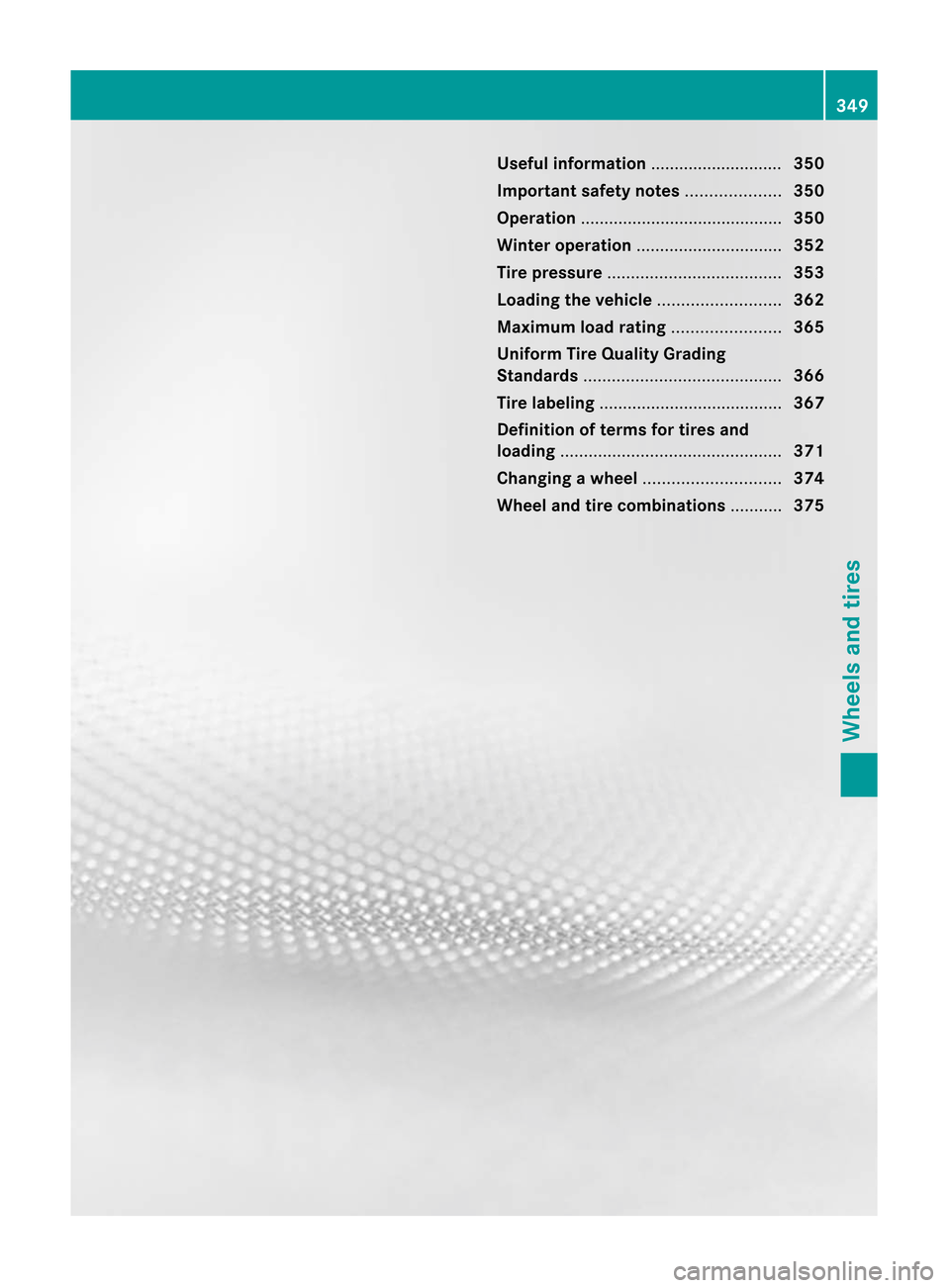
Useful
information........ .......... .......... 350
Impor tantsafet ynotes .................... 350
Opera tion........................... ......... ....... 350
Winter operation............................... 352
Tir epr essure ..................................... 353
Loading thevehicle .......................... 362
Maxim umload rating ....................... 365
Uniform TireQualit yGra ding
Sta ndar ds.......................................... 366
Tir elabeling .................................... ... 367
Definition ofter ms fortires and
loading ............................................... 371
Changing awhee l............................. 374
Wheel andtirecombinat ions........... 375 349Wheels and tires
Page 352 of 396
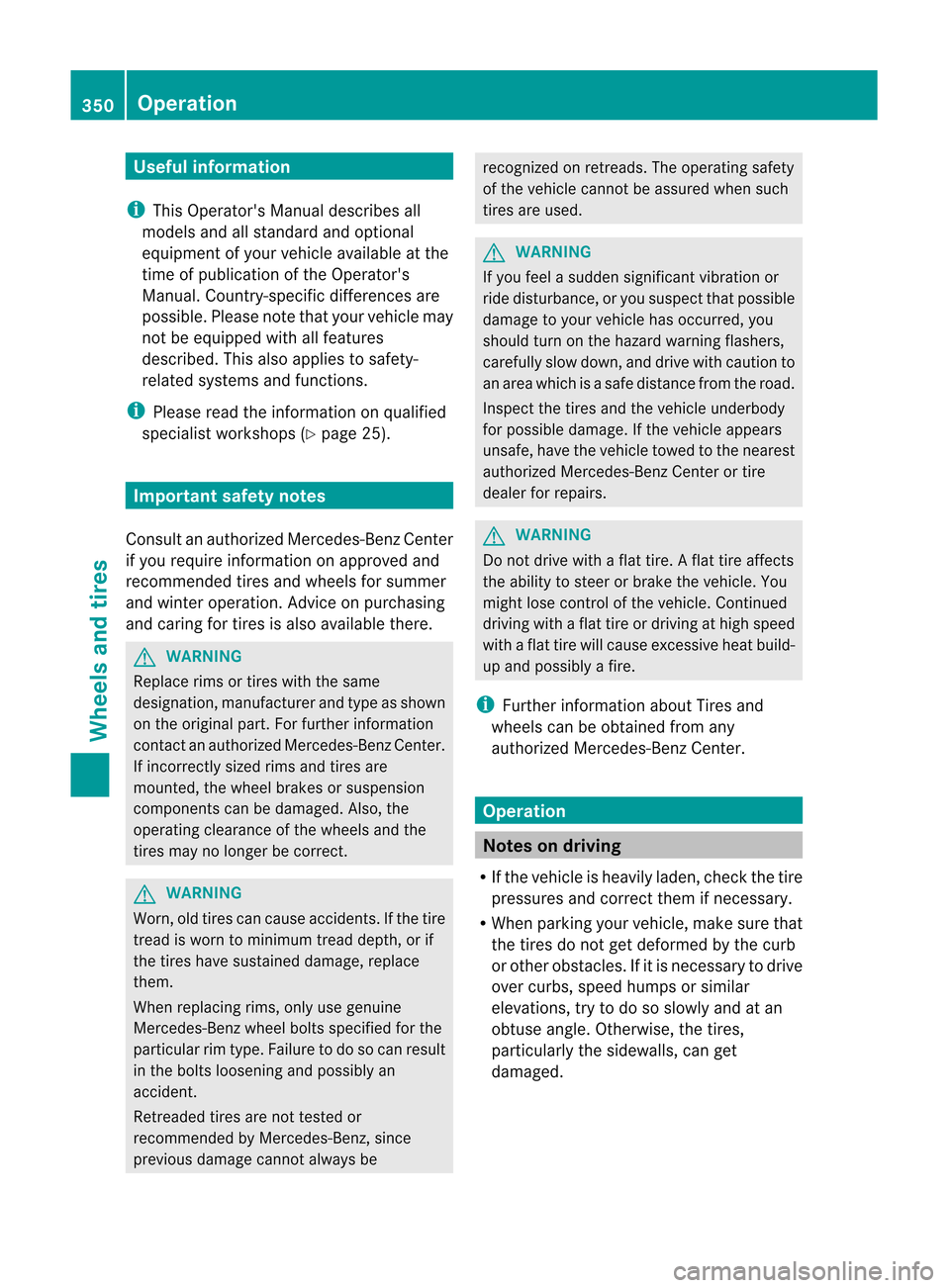
Useful
information
i This
Operat or'sManual describesall
models andallstan dard andoption al
equipment ofyour vehicle available atthe
time ofpublication ofthe Operat or's
Manual. Country-specificdiffer encesare
possible. Pleasenotethat your vehicle may
not beequipped withallfeature s
descr ibed. Thisalso applies tosafet y-
related systemsand func tions. i
Please
readtheinfor mation onqualified
specialist workshops(Ypage 25). Impor
tant safet ynotes Consult
anauthoriz edMerc edes-B enzCent er
if you require information onapproved and
recom mende dtires andwheels forsummer
and winteroperation .Advice onpurchasin g
and carin gfor tires isalso available there. G
WARN
ING Replace
rimsortires withthesame
designat ion,manufac turerandtype asshown
on the original part.Forfurther infor mation
con tact anauthoriz edMerced es-BenzCente r.
If inco rrectlysized rimsandtires are
mount ed,the wheel brakes orsuspension
compon entscan bedamaged. Also,the
operatin gclearanc eof the wheels andthe
tires maynolonger becorr ect. G
WARN
ING Worn
,old tires cancause acciden ts.Ifthe tire
tread isworn tominimum treaddepth, orif
the tires have sustaine ddamage, replace
them .
When replacin grims, onlyusegenuine
Mercede s-Benz wheel boltsspecified forthe
partic ularrimtype. Failure todo socan result
in the bolts loosenin gand possibly an
acciden t.
Retreaded tiresarenot testedor
recom mended byMercede s-Benz ,sinc e
previous damagecannotalways be recog
nized on retr eads. Theoperatin gsafety
of the vehicle cannotbe assured whensuch
tires areused. G
WARN
ING If
you feel asudden significantvibration or
ride disturban ce,oryou suspect thatpossible
damage toyour vehicle hasoccurred, you
should turnonthe hazard warning flashers,
carefully slowdown, anddrive withcaution to
an area which isasafe distan cefrom theroad.
Inspe ctthe tires andthevehicle underbody
for possible damage. Ifthe vehicle appears
unsafe, havethevehicle towedtothe nearest
authoriz edMercede s-Benz Cente ror tire
dealer forrepairs. G
WARN
ING Do
not drive withaflat tire. Aflat tire affect s
the ability tosteer orbrake thevehicle. You
might losecontrolof the vehicle. Continued
drivin gwith aflat tire ordrivin gat high speed
with aflat tire willcause excessive heatbuild-
up and possibly afire. i
Furt
herinfor mation aboutTiresand
wheels canbeobtained fromany
authoriz edMercede s-Benz Cente r. Oper
ation Not
eson driving
R Ifthe vehicle isheavily laden,checkthe tire
pressures andcorrect themifnecessary.
R When parking yourvehicle, makesurethat
the tires donot getdeformed bythe curb
or other obstacles. Ifit is necessary todrive
over curbs, speedhumps orsimilar
elevations, trytodo soslowly andatan
obtuse angle.Otherwise, thetires,
particularly thesidewa lls,can get
damaged. 350
Operat
ionWheels and tires
Page 353 of 396
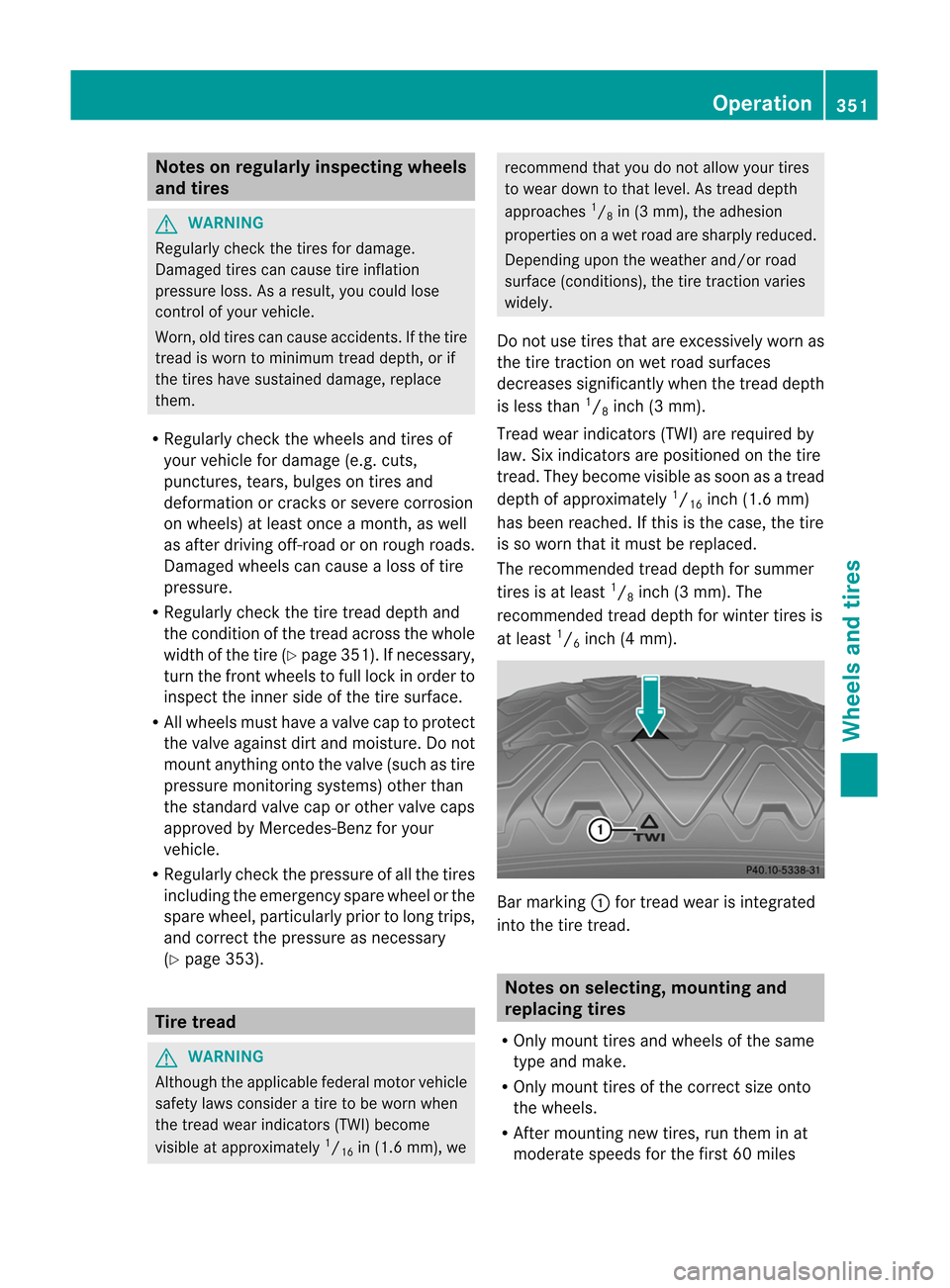
Note
son reg ularly inspe cting wheels
and tires G
WA
RNI NG Re
gularly che ckthe tires for dama ge.
Dam aged tires can causetireinf latio n
pre ssu reloss. Asares ult, yo ucou ldlose
contr olof your veh icle.
Wo rn,oldtir es can causeacc idents .Ift he tire
tread isworn tominimum treaddepth, orif
the tires have sustained damage,replace
them.
R Regul arlycheck thewheels andtires of
your vehicle fordamage (e.g.cuts,
punctures, tears,bulges ontires and
deformation orcrack sor severe corrosion
on wheels) atleast once amonth,as well
as after driving off-road oron rough roads.
Damaged wheelscancause aloss oftire
pressure.
R Regula rlycheck thetire tread depth and
the condit ionofthe tread across thewhole
width ofthe tire (Ypage 351). Ifnecessary,
turn thefront wheels tofull lock inorder to
inspect theinner sideofthe tire surface.
R All wheels musthaveavalve captoprotec t
the valve against dirtand moisture. Donot
mount anything ontothe valve (such astire
pressure monitoringsystems) otherthan
the standard valvecaporother valvecaps
approved byMercedes-B enzforyour
vehicle.
R Regula rlycheck thepressure ofall the tires
including theemergenc yspare wheel orthe
spare wheel, particularly priortolong trips,
and correc tthe pressure asnecessary
(Y page 353). Tire
tread G
WARNING Although
theappli cable federal motorvehicle
safety lawsconsider atire tobe worn when
the tread wearindicators (TWI)become
visible atapproximately 1
/ 16 in
(1.6 mm), we recommen
dthat youdonot allow yourtires
to wear down tothat level. Astread depth
approaches 1
/ 8 in
(3 mm), theadhesion
properties onawet road aresharply reduced.
Depending upontheweather and/orroad
surface (conditions), thetire tract ionvaries
widely .
Do not use tires thatareexcessively wornas
the tire tract iononwet road surfaces
decreases significantly whenthetread depth
is less than 1
/ 8 inch
(3mm).
Tread wearindicators (TWI)arerequired by
law. Sixindicators arepositioned onthe tire
tread. Theybecome visibleassoon asatread
depth ofapproximately 1
/ 16 inch
(1.6mm)
has been reached. Ifthis isthe case, thetire
is so worn thatitmust bereplaced.
The recommen dedtread depth forsummer
tires isat least 1
/ 8 inch
(3mm). The
recommen dedtread depth forwinter tiresis
at least 1
/ 6 inch
(4mm). Bar
marking :for tread wearisintegrated
into thetire tread. Notes
onselec ting,mounting and
replacing tires
R Only mount tiresandwheels ofthe same
type andmake.
R Only mount tiresofthe correct sizeonto
the wheels.
R Aft ermounting newtires, runthem inat
moderate speedsforthe first 60miles Operat
ion
351Wheels and tires Z
Page 354 of 396
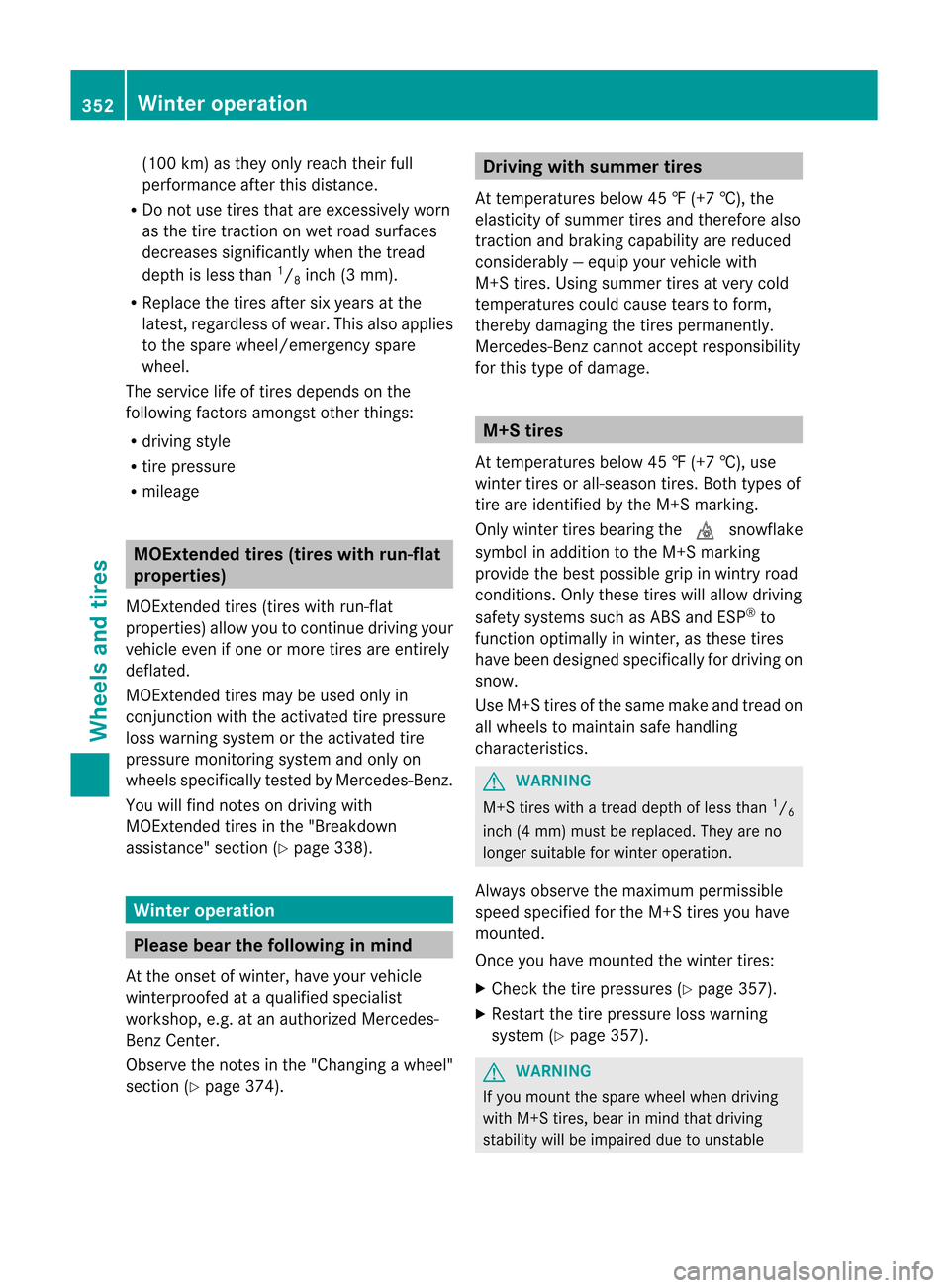
(100
km)as they onlyreach theirfull
perfo rmanceafter thisdistan ce.
R Do not use tiresthat areexcessively worn
as the tire tract ion onwet road surfac es
decr eases significantlywhen thetread
depth isless than 1
/ 8 inc
h(3 mm).
R Replace thetiresafter sixyears atthe
latest ,regardles sof wear. Thisalso applies
to the spare wheel/em ergencyspare
wheel.
The servicelife oftire sdepends onthe
followin gfact orsamong stothe rthings:
R driving style
R tire pressure
R mileage MOExtended
tires(tires withrun-flat
proper ties)
MOExt ended tires(tires withrun-flat
properties) allowyoutocont inue driving your
vehicle evenifone ormore tiresareentirely
deflated.
MOExt ended tiresmaybeused onlyin
conj unction withtheactivated tirepressure
loss warning systemorthe activated tire
pressure monitorin gsystem andonly on
wheels specifically testedbyMercedes-Ben z.
You willfind notes ondriving with
MOExt ended tiresinthe "Breakdown
assistance" section(Ypage 338). Winter
operation Please
bearthefollow inginmind
At the onset ofwinter, haveyourvehicle
winterproofed ataqual ified specialist
workshop, e.g.atan authorized Mercedes-
Benz Center.
Observe thenotes inthe "Cha nging awheel"
section (Ypage 374). Driving
withsumm ertires
At temperatures below45‡(+7 †), the
elasticity ofsummer tiresandtherefore also
tract ionand braking capabilityare reduced
considerably —equip your vehicle with
M+S tires.Using summer tiresatvery cold
temper aturescouldcause tearstoform ,
ther eby damaging thetires perman ently.
Mercede s-Benz cann otaccept responsibility
for this type ofdamage. M+S
tires
At temper aturesbelow45‡(+7 †), use
winter tiresorall-season tires.Both types of
tire areidentified bythe M+S marking.
Only winter tiresbearing thei snowflake
symbol inaddition tothe M+S marking
provide thebest possible gripinwintry road
condit ions.Onlythese tireswillallow driving
safety systems suchasABS andESP®
to
funct ionoptimally inwinter, asthese tires
have been designed specifically fordriving on
snow.
Use M+S tiresofthe same make andtread on
all wheels tomaintain safehandling
charact eristics. G
WARNIN
G M+S
tireswithatread depth ofless than 1
/ 6
inch (4mm) must bereplaced. Theyareno
longer suitable forwinter operation.
Always observe themaximum permissible
speed specified forthe M+S tiresyouhave
mounted.
Once youhave mounted thewinter tires:
X Check thetire pressures (Ypage 357).
X Restart thetire pressure losswarning
system (Ypage 357). G
WARNIN
G If
you mount thespare wheel whendriving
with M+S tires, bearinmind thatdriving
stability willbeimpaired duetounstable 352
Winter
operationWheels and tires
Page 355 of 396
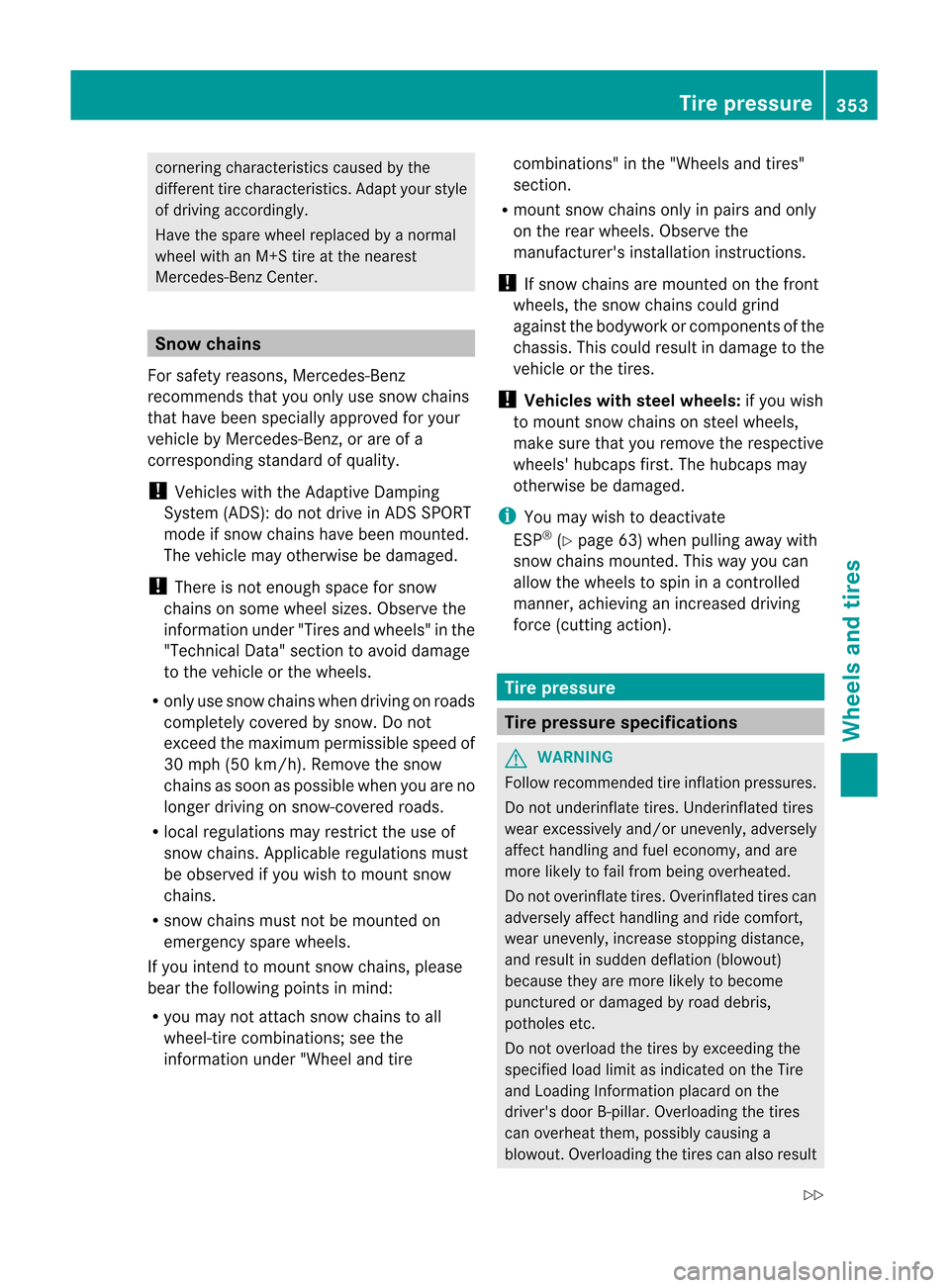
corner
ingcharacte ristics caused bythe
di ffere nttire characte ristics. Adaptyour styl e
of dri ving acco rdingly .
Have thesparewhe elrep laced byanorma l
whe elwith an M+S tireatthe nearest
Merce des-Benz Center. Sno
wchai ns
For safety reasons, Merce des-Benz
recom mends thatyouonly usesnow chains
that have bee nspecially approved foryour
vehicle byMercede s-Benz ,or are ofa
corr espondin gstan dard ofquality.
! Vehicles withtheAdapt iveDampin g
Syst em(ADS):donot drive inAD SSPORT
mode ifsnow chains havebeen mount ed.
The vehicle mayother wisebedamaged.
! There isnot enough spaceforsnow
chains onsome wheel sizes.Observ ethe
infor mation under"Tiresandwheels" inthe
"Techn icalData"sect iontoavoid damage
to the vehicle orthe wheels.
R only usesnow chains whendrivingon roads
complet elycover edbysnow. Donot
exc eed themaximum permissible speedof
30 mph (50km/ h).Remove thesnow
chains assoon aspossible whenyouareno
longer drivingon snow- coveredroads.
R local regulation smay restrict theuse of
snow chains .Applicable regulation smust
be observed ifyou wish tomount snow
chains .
R snow chains mustnotbemount edon
emergen cyspare wheels.
If you intend tomount snowchains ,please
bear thefollowing pointsin mind:
R you may notattach snow chains toall
wheel-t irecombin ations;see the
infor mation under"Wheel andtire combin
ations"in the "Wheels andtires "
sect ion.
R mount snowchains onlyinpairs andonly
on the rear wheels. Observethe
manufacturer's installationinstructions.
! Ifsnow chains aremounted onthe front
wheels, thesnow chains couldgrind
against thebodyw orkorcomponen tsof the
chassis. Thiscould result indamage tothe
vehicle orthe tires.
! Vehicles withsteel wheels :if you wish
to mount snowchains onsteel wheels,
make surethatyouremove therespective
wheels' hubcaps first.Thehubcaps may
otherwise bedamaged. i
You
may wish todeactivate
ESP ®
(Y page 63)when pullingaway with
snow chains mounted. Thiswayyoucan
allow thewheels tospin inacont rolled
manner, achieving anincreased driving
force (cuttin gaction). Tire
pressur e Tire
pressur especific ations G
WARNING Follow
recommen dedtireinflation pressures.
Do not underinflate tires.Underinflated tires
wear excessively and/orunevenly, adversely
affect handling andfuel economy, andare
more likelytofail from being overheated.
Do not overinflate tires.Overinflated tirescan
adversely affecthandling andride comfort ,
wear unevenly, increasestopping distance,
and result insudden deflation (blowout)
because theyaremore likelytobecome
punctured ordamaged byroad debris,
potholes etc.
Do not overload thetires byexceeding the
specified loadlimit asindicated onthe Tire
and Loading Informationplacard onthe
driver's doorB-pillar. Overloading thetires
can overheat them,possibly causinga
blowou t.Overloading thetires canalso result Tire
pressure
353Wheels and tires
Z
Page 356 of 396
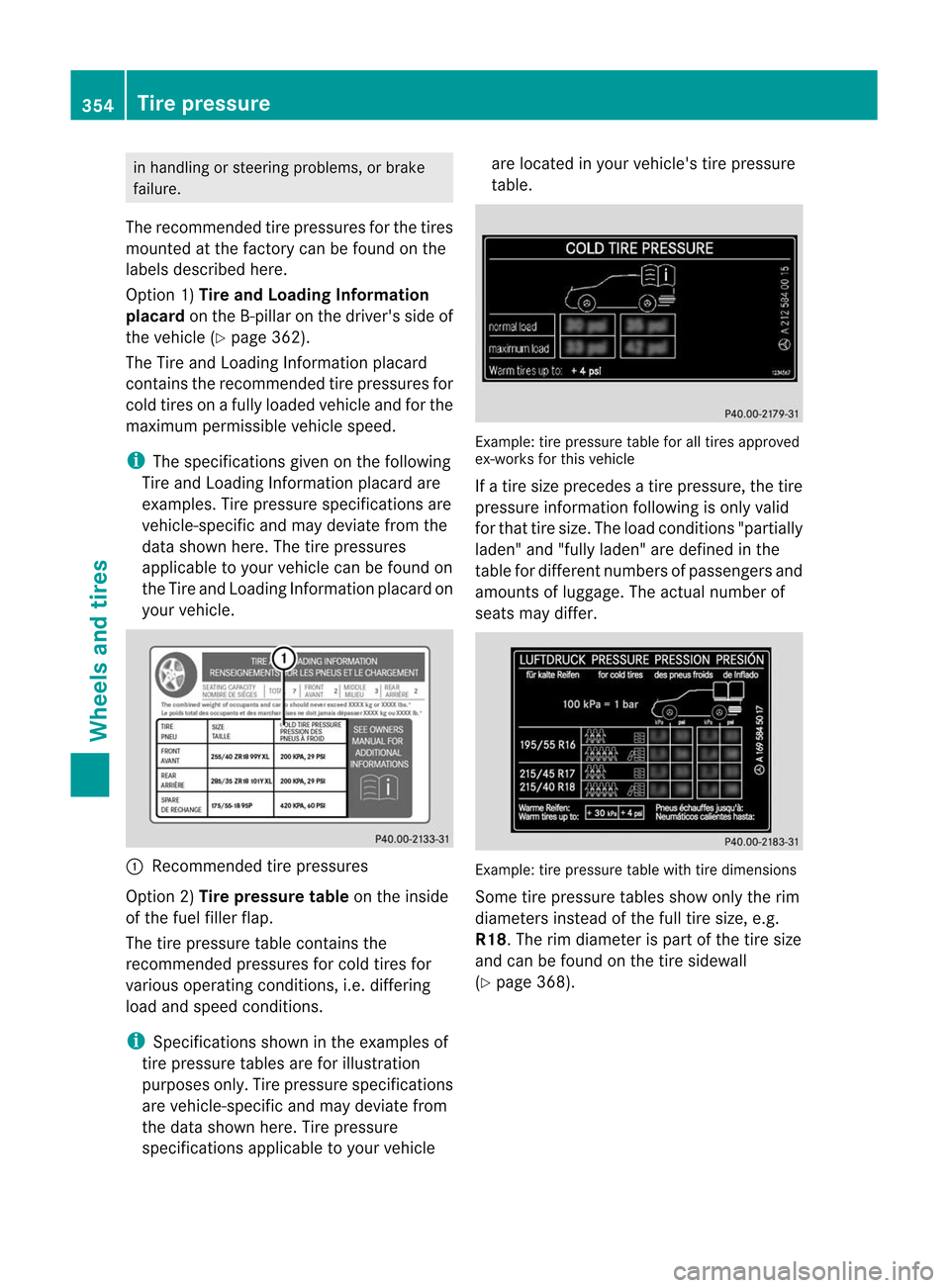
in
handlin gor ste erin gproblem s,or brak e
failure.
The recomme ndedtirepress uresforthe tires
moun tedatthe factorycan befoun don the
labels described here.
Opt ion 1)Tir eand Loadin gInfor mation
pla car don the B-pillar onthe drive r'sside of
the vehic le(Y page 362).
The Tire andLoadin gIn for matio nplacard
con tain sthe recomm endedtir epress uresfor
cold tires on afully loaded vehicleand forthe
maxim umperm issible vehiclespeed. i
The
spec ification sgiven onthe followin g
Tire andLoadin gIn for mat ionplacard are
exam ples.Tirepress urespec ification sare
vehic le-specif icand may deviat efro mt he
data shown here.Thetirepressures
appli cable toyour vehicle canbefound on
the Tire andLoading Informationplacard on
your vehicle. :
Recommended tirepressures
Option 2)Tire pressur etable onthe inside
of the fuel filler flap.
The tirepressure tablecontains the
recommen dedpressures forcold tires for
various operating conditions,i.e. differing
load andspeed condition s. i
Specifications
showninthe examples of
tire pressure tablesareforillustration
purposes only.Tirepressure specifications
are vehicle-specific andmay deviate from
the data shown here.Tirepressure
specifications applicable toyour vehicle are
located inyour vehicle's tirepressure
table. Example:
tirepressure tableforalltires approved
ex-works forthis vehicle
If atire size precedes atire pressure, thetire
pressure information followingisonly valid
for that tiresize. Theload condition s"partiall y
laden" and"fully laden" aredefined inthe
table fordifferent numbers ofpassengers and
amounts oflugga ge.The actual number of
seats maydiffer. Example:
tirepressure tablewithtiredimensions
Some tirepressure tablesshowonlytherim
diameters insteadofthe fulltire size, e.g.
R18. Therimdiameter ispart ofthe tire size
and canbefound onthe tire sidewa ll
(Y page 368). 354
Tire
pressureWheels and tires
Page 357 of 396
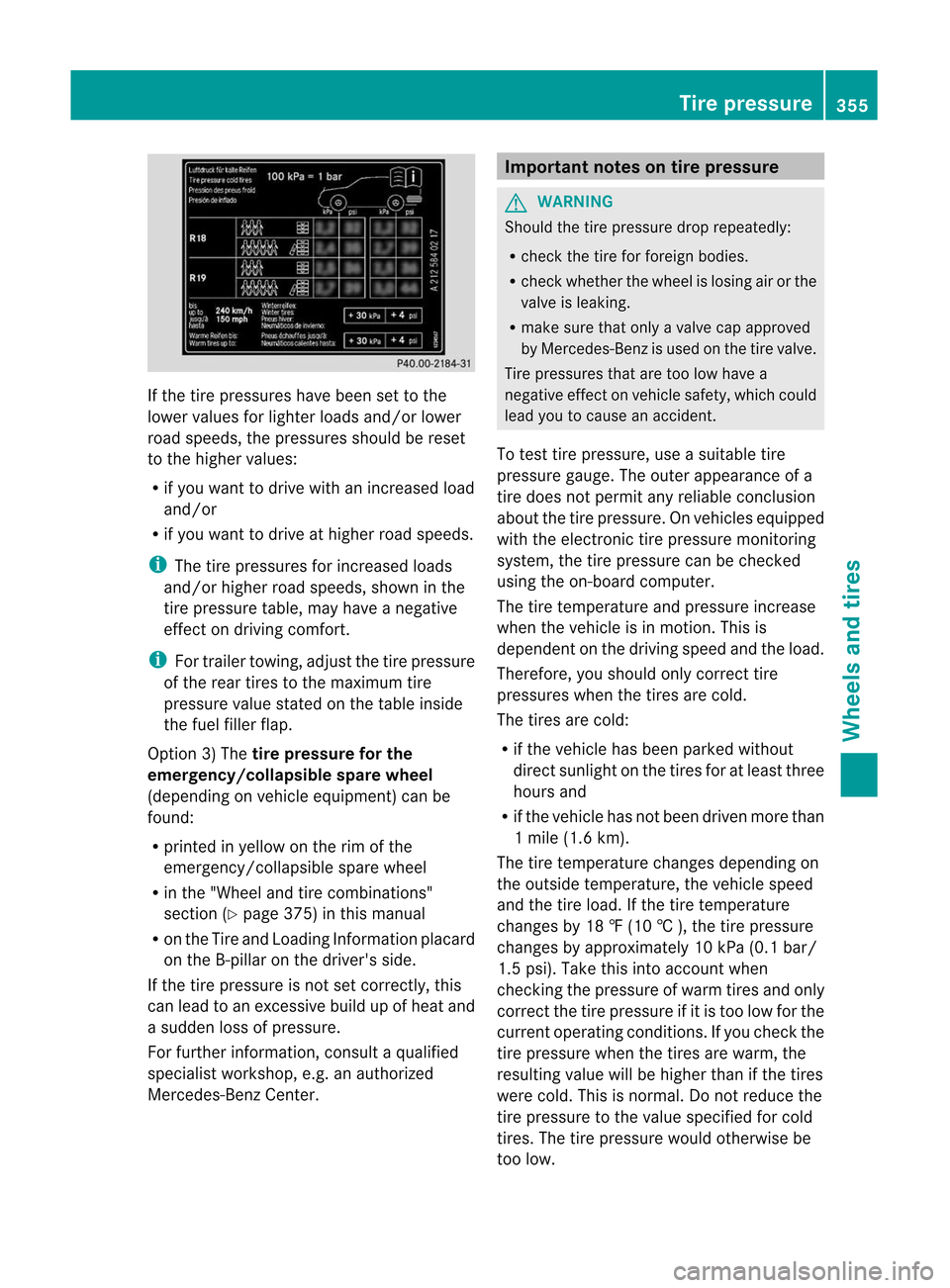
If
the tire pressu reshave been settothe
lowe rvalues forlight erloads and/or lower
road speeds,thepres suressho uld beres et
to thehigh ervalues :
R ifyou want todriv ewit han increas edload
and /or
R ifyou want todriv eat high erroad speeds. i
The
tirepres suresfor increas edloads
and /or high erroad speeds,sho wninthe
tir epres sure table,may have ane gat ive
eff ect ondriv ingcomf ort . i
For
trailer towing ,adj ust thetir epres sure
of therear tires tothemax imum tire
pres sure value state don thet able inside
th efuel fillerflap.
Opt ion 3)The tirepr essur efor the
emer gency/collap siblesparewheel
(depen dingonvehic leequipmen t)can be
foun d:
R prin tedinyellow onthe rim ofthe
emer gency/c ollapsible sparewheel
R in the "Wheel andtirecom binat ions"
sect ion(Ypage 375)in this manual
R on the Tire andLoadin gIn for mat ionplacard
on the B-pillar onthe drive r'sside.
If the tirepress ureisnot setcorrectly, this
can lead toan exc essiv ebuild upofheat and
a sudde nloss ofpressure.
For further information,consult aquali fied
specialist workshop, e.g.anauthorized
Mercedes-B enzCenter. Import
antnotes ontire pressur e G
WARNIN
G Should
thetire pressure droprepeatedly:
R check thetire forforeign bodies.
R check whether thewheel islosing airorthe
valve isleaking.
R make surethatonly avalve capapproved
by Mercedes-B enzisused onthe tire valve.
Tire pressures thataretoo low have a
negative effectonvehicle safety,whichcould
lead youtocause anaccident .
To test tirepressure, useasuitable tire
pressure gauge.Theouter appearance ofa
tire does notpermit anyreliable conclusion
about thetire pressure. Onvehicles equipped
with theelectron ictire pressure monitoring
system, thetire pressure canbecheck ed
using theon-board computer.
The tiretemperat ureand pressure increase
when thevehicle isin motion .This is
dependent onthe driving speedandtheload.
Therefore, youshould onlycorrect tire
pressures whenthetires arecold.
The tires arecold:
R ifthe vehicle hasbeen parked without
direct sunlight onthe tires foratleast three
hours and
R ifthe vehicle hasnotbeen driven morethan
1 mile (1.6km).
The tiretemperature changesdepending on
the outside temperature, thevehicle speed
and thetire load. Ifthe tire temperature
changes by18 ‡(10 †),the tire pressure
changes byapproximately 10kPa (0.1 bar/
1.5 psi). Take thisinto account when
check ingthe pressure ofwarm tiresandonly
correct thetire pressure ifit is too low forthe
current operating conditions.Ifyou check the
tire pressure whenthetires arewarm, the
resulting valuewillbehigher thanifthe tires
were cold.Thisisnormal. Donot reduce the
tire pressure tothe value specified forcold
tires. Thetirepressure wouldotherwise be
too low. Tire
pressure
355Wheels and tires Z
Page 358 of 396

Observe
therecommended tirepressures for
cold tires
R on the Tire andLoading Information placard
on the B-pillar onthe driver's side,
R in the tire pressure tableonthe inside of
the fuel filler flap,
R printed inyell ow onthe rim ofthe
emergency/collapsib lespare wheel
(depending onvehicle equipment). Underinflated
oroverinflated tires
Underinflated tires G
WARNING Follow
recommended tireinflation pressures.
Do not underinflate tires.Underinflated tires
wear excessively and/orunevenly, adversely
affect handling andfuel economy, andare
more likelytofail from being overheated.
Underinflated tirescan:
R wear excessively and/orunevenly
R adversely affectfueleconomy
R fail from being overheated
R adversely affecthandling
Overinflated tires G
WARNING Follow
recommended tireinflation pressures.
Do not overinflate tires.Overinflated tirescan
adversely affecthandling andride comfort ,
wear unevenly, increasestopping distance,
and result insudden deflation (blowout)
because theyaremore likelytobecome
punctured ordamaged byroad debris,
potholes etc.
Overinflated tirescan:
R adversely affecthandling
R wear excessively and/orunevenly
R be more likelytobecome damaged R
adversely affectridecomfort
R increase stopping distance
Maximum tirepressure G
WARNING Never
exceed themaximum tireinflation
pressure. Followrecommended tireinflation
pressures.
Do not underinflate tires.Underinflated tires
wear excessively and/orunevenly, adversely
affect handling andfuel economy, andare
more likelytofail from being overheated.
Do not overinflate tires.Overinflated tirescan
adversely affecthandling andride comfort ,
wear unevenly, increasestopping distance,
and result insudden deflation (blowout)
because theyaremore likelytobecome
punctured ordamaged byroad debris,
potholes etc. :
Maximum permittedtirepressure
(example) i
The
actual valuesfor tires arespecific to
each vehicle andmay deviate fromthe
value sin the illustration.
When adjusting thetire pressures always
observe therecommended tirepressure for
your vehicle (Ypage 353). 356
Tire
pressur eWheels and tires
Page 359 of 396
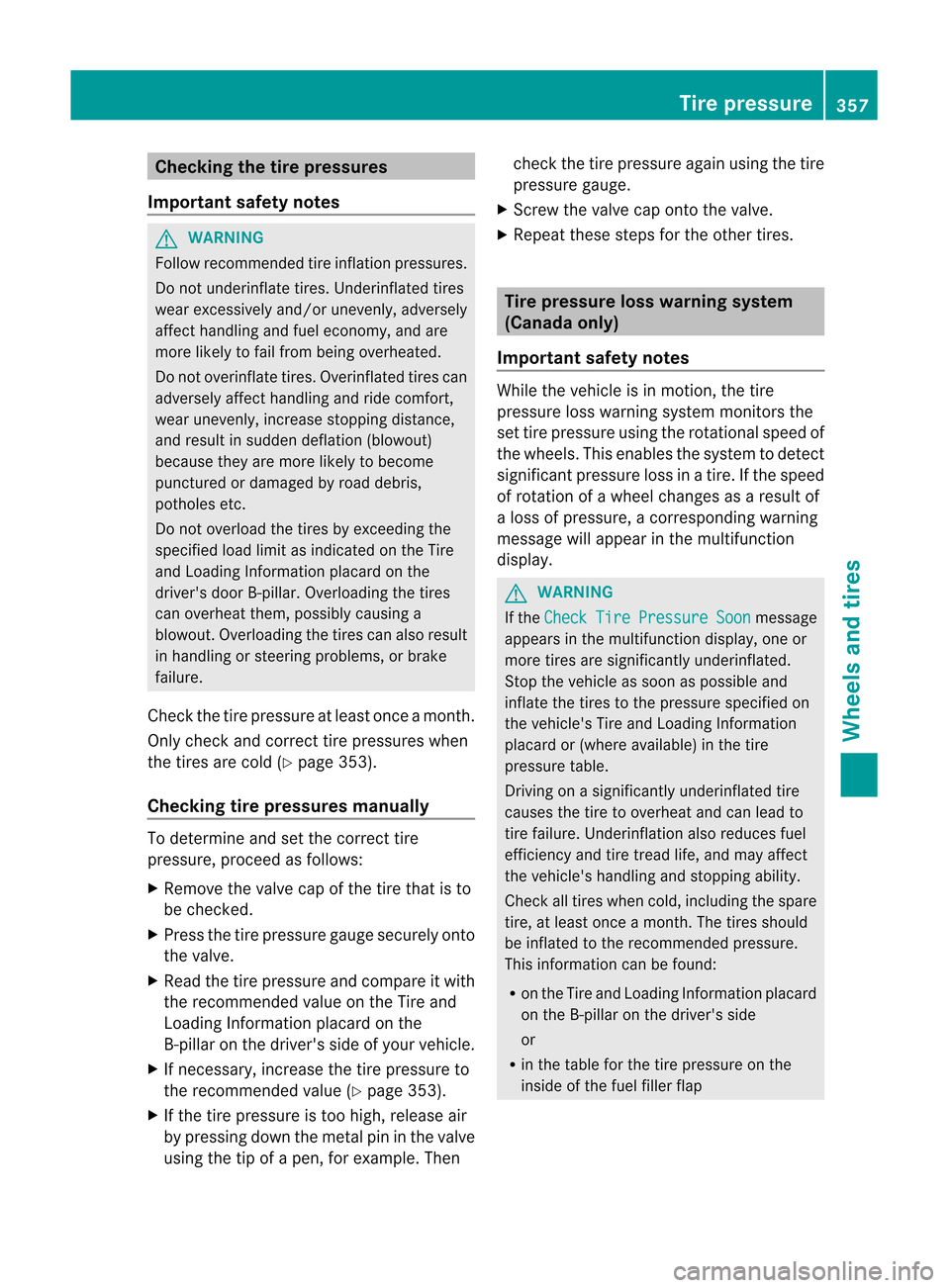
Check
ingthetir epr essu res
Imp ortant safety notes G
WAR
NING Fol
low recomm ended tireinf lati onpres sures.
Do notunde rinflat etir es. Underi nflate dtir es
wear exces sively and /or unevenly,adve rsely
aff ect handlingand fuel economy, and are
mor elik ely tofail from bein gove rheated.
Do notoverinfla tetires. Overinfla tedtires can
adve rsely affect handlingand ride comfort,
wea runeve nly,incre asestop ping dista nce,
and resulti ns udden deflation (blowo ut)
bec ause they are mor elik ely tobec ome
pun ctured ordamag edbyroad debris,
pot hole set c.
Do noto verloa dthe tires byexceedi ngthe
specifi edloadlimi tasindicated onthe Tire
and Loading Information placardonthe
driver's doorB-pillar. Overloading thetires
can overheat them,possibly causinga
blowou t.Overloading thetires canalso result
in handling orsteering problems, orbrake
failu re.
Check thetire pressure atleast once amonth.
Only check andcorrect tirepressures when
the tires arecold (Ypage 353).
Checki ngtire pressures manually To
determine andsetthe correct tire
pressure, proceedasfollows:
X Remove thevalve capofthe tire that isto
be checked.
X Press thetire pressure gaugesecurely onto
the valve.
X Read thetire pressure andcompare itwith
the recommended valueonthe Tire and
Loading Information placardonthe
B-pillar onthe driver's sideofyour vehicle.
X Ifnecessary, increasethetire pressure to
the recommended value(Ypage 353).
X Ifthe tire pressure istoo high, release air
by pressing downthemetal pininthe valve
using thetipofapen, forexample. Then check
thetire pressure againusing thetire
pressure gauge.
X Screw thevalve caponto thevalve.
X Repea tthese steps forthe other tires. Tire
pressur eloss warning system
(Canada only)
Import antsafety notes While
thevehicle isin motion, thetire
pressure losswarning systemmonitors the
set tire pressure usingtherotational speedof
the wheels. Thisenables thesystem todetect
significant pressurelossinatire. Ifthe speed
of rotation ofawheel changes asaresult of
a loss ofpressure, acorresponding warning
message willappea rint he multifunction
displa y. G
WARNING If
the Check Tire Pressure Soon message
appears inthe multifunction display,one or
more tiresaresignificantly underinflated.
Stop thevehicle assoon aspossible and
inflate thetires tothe pressure specified on
the vehicle's TireandLoading Information
placard or(where available)inthe tire
pressure table.
Driving onasignificantly underinflated tire
causes thetire tooverheat andcanlead to
tire failure. Underinflation alsoreduces fuel
efficiency andtiretread life,and may affect
the vehicle's handlingandstopping ability.
Check alltires when cold,including thespare
tire, atleast once amont h.The tires should
be inflated tothe recommen dedpressure.
This information canbefound:
R on the Tire andLoading Informationplacard
on the B-pillar onthe driver's side
or
R in the table forthe tire pressure onthe
inside ofthe fuel filler flap Tire
pressure
357Wheels and tires Z
Page 360 of 396
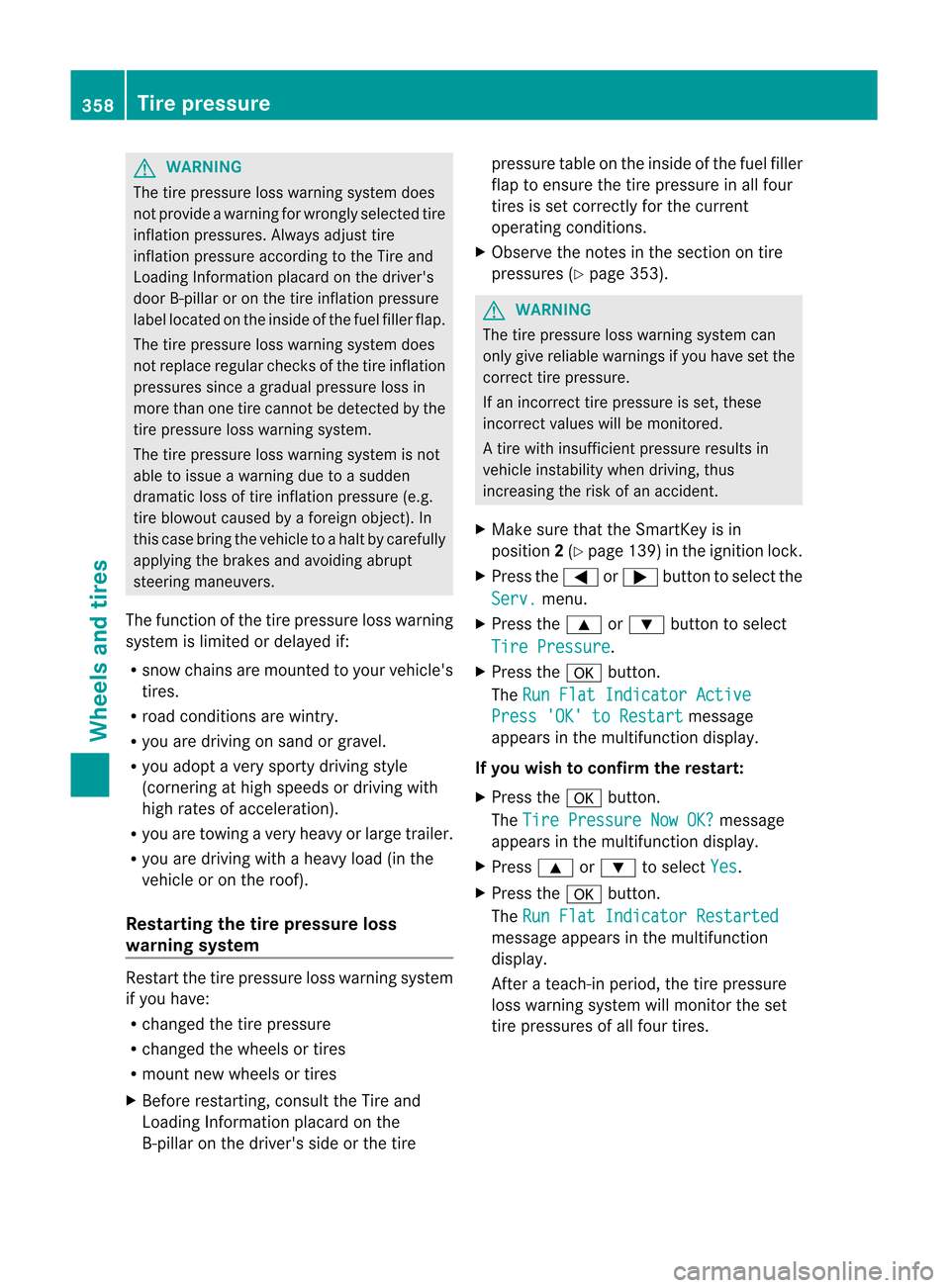
G
WARNING The
tirepressu reloss warni ngsystem does
not provid eawar ning forwrongl ysele cted tire
infla tion pressu res.Alwa ysadju sttire
infla tion pressu reaccordi ngtothe Tire and
Load ingInformation placard onthe drive r's
door B-pillaror on the tire infla tion pressu re
lab elloca tedonthe insid eof the fuel filler flap .
The tirepressu reloss warni ngsystem does
not repl ace regu larchecks ofthe tire infla tion
pressu ressince agrad ualpressu reloss in
more thanonetirecannot bedetected bythe
tire pressu reloss warning system.
The tirepressu reloss warni ngsystem isnot
abl eto issu eawar ning duetoasud den
drama ticloss oftire infla tion pressu re(e.g.
tire blow outcaus edbyaforeig nobjec t).In
this case bring thevehicle toahalt bycarefully
applying thebrakes andavoiding abrupt
steer ingmaneuver s.
The func tionofthe tire pressure losswarning
system islimited ordelayed if:
R snow chains aremount edtoyour vehicle's
tires.
R road condition sare wintr y.
R you aredriving onsand orgravel.
R you adopt avery sport ydriving style
(corn ering athigh speeds ordriving with
high rates ofaccelerat ion).
R you aretowing avery heavy orlarge trailer.
R you aredriving withaheavy load(inthe
vehicle oron the roof).
Resta rting the tirepr essure loss
warning system Restart
thetire pressure losswarning system
if you have:
R chang edthe tire pressure
R chang edthe wheels ortires
R mount newwheels ortires
X Befor erest artin g,con sult theTire and
Loading Informat ionplacard onthe
B- pillar onthe driver's sideorthe tire pressure
tableonthe inside ofthe fuel filler
flap toensure thetire pressure inall four
tires isset corr ectlyfor the curren t
operatin gcon dition s.
X Observe thenotesinthe sect ionontire
pressures (Ypage 353). G
WARN
ING The
tirepressure losswarning systemcan
only givereliable warning sif you have setthe
corr ecttire pressure.
If an incor recttirepressure isset, these
incor rectvalues willbemonit ored.
At ire with insufficientpress ureresult sin
vehic leinst ability whendriving,thus
inc reasin gthe risk ofan acc ident .
X Make surethattheSmartKey isin
posit ion2(Y page 139)int he ignition lock.
X Press the= or; button toselect the Serv. menu.
X Press the9 or: button toselect Tire
Pressure .
X Press thea button.
The Run
Flat Indicator Active Press
'OK'toRestart message
appea rsinthe multifunction display.
If you wish toconfirm therestar t:
X Press thea button.
The Tire
Pressure NowOK? message
appea rsinthe multifunction display.
X Press 9or: toselect Yes .
X Press thea button.
The Run
Flat Indicator Restarted message
appearsinthe multifunction
displa y.
Aft erateach-in period,thetire pressure
loss warning systemwillmonitor theset
tire pressures ofall four tires. 358
Tire
pressureWheels and tires